Product Information
Matelier's features
1. Carefully selected waste materials are used
Virgin plastic is appealing because there is no degradation or contamination of the raw material and the variability in physical properties can be reduced. In contrast, there is concern that recycled plastic made from waste materials will have greater variability in physical properties than virgin plastic.
To address these concerns with recycled plastic, Matelier uses waste materials that are used briefly and that have relatively little degradation. For example, jugs and bottles such as milk bottles, water bottles, and PET bottles that are discarded as soon as the liquid is consumed are used as raw materials. In addition, it uses CDs and DVDs that have been used indoors and in cars, and it also uses gaming machines that have been used in air-conditioned rooms and that are swapped out every three to five years. By using these carefully selected waste materials, Konica Minolta is able to control the variability in physical properties and ensure that the properties are nearly equivalent to those of virgin plastic.


2. A high ratio of waste-derived plastic (a high ratio of post-consumer recycled (PCR) material) is used
One of the recycled plastics produced by material recycling is a PCR material, and PCR material refers to "recycled plastic made from plastic that has been used and disposed of by general consumers." The ratio of PCR material is "the percentage of waste-derived plastic contained in recycled plastic." If the ratio of PCR material is 100%, this means that the recycled plastic is made solely from waste-derived plastic.
If the ratio of PCR material is not 100%, then in some cases the following may be included in addition to waste-derived plastic:
- Various additives (e.g., flame retardants and toughening agents)
- Colorants (e.g., pigments)
- Virgin petroleum-based plastic
These substances are added to ensure desired physical properties such as strength and color and to add new functionality. Using Konica Minolta's recycled plastic as an example, the recycled plastic used in the exterior of MFPs includes a "flame retardant" that has been added to waste-derived plastic. This gives it a new functionality, "flame retardance," that waste-derived plastic lacked. Pigments are also added to the exterior materials to make the colors specified by Konica Minolta.
Konica Minolta's recycled plastic features a high ratio of waste-derived plastic (a high ratio of PCR material) while ensuring the desired colors and adding new functionality.
Konica Minolta has several lineups of recycled plastic. "R-ABS (standard)," "R-PC (high strength)," "R-PC (highly moldable)" and "R-HDPE (standard)" have a ratio of PCR material of 100%.
The use of a high ratio of PCR material will also increase the ratio of PCR material in the product (the percentage of recycled plastic used in the product). Using the ratio of PCR material in Konica Minolta's MFPs as an example, "R-PC/PET" with a high ratio of PCR material (70%) is used as an exterior material. "R-ABS" with a high ratio of PCR material (100%) is used as an interior material, and "R-HDPE" with a high ratio of PCR material (100%) is used in toner bottles. Use of such a high ratio of PCR material has enabled the use of recycled plastic in 35% of the components in all MFPs.
In addition, the EU is considering the pioneering introduction of regulations for plastic packaging materials, and the target for 2030 is to use 10%-35% PCR material in plastic packaging materials (ratio of PCR material: 10%-35%). With a target of 50%-65% by 2040, the required ratio of PCR material is expected to continue to increase. From this regulatory perspective, an effective approach would be to consider the use of a high ratio of PCR material.




3. Traceable
Konica Minolta collects the raw materials and can provide recycled plastic that is definitely made from waste plastic.
We also have a detailed understanding of what waste plastic is being procured,which allows its effective use and which helps to control variability in the physical properties of the recycled plastic. In specific terms, we know the types and properties of plastic used in the waste materials we procure such as how the materials were used and how often they were replaced before they became waste.
In the unlikely event of a defect, the cause can easily be identified and measures can be taken, allowing a prompt response. Defects can be caused by "the collected waste material itself" and various elements and processes "during pellet production," "during pellet storage," and "during pellet formation." Konica Minolta facilitates a review of the data by tracing the defect back to these processes.


In addition to the three characteristics of "the waste materials used," "the ratio of PCR material," and "traceability," Matelier is also able to provide assistance regarding the use of recycled plastic. Konica Minolta is involved in the use of recycled plastic, from development to molding, and we have been using the recycled plastic we developed in our own products for over a decade, and there are also examples of other companies using that recycled plastic as well. As we have achieved these successes, we have amassed the following technologies:
- Pretreatment (sorting and cleaning) technology
- Kneading technology
- Material modification technology
- Component design technology
- Molding technology
Using these technologies, we can provide recycled plastic and also assist you in starting production, including mold design and molding, and we can obtain the EcoLeaf environmental label for use of recycled plastic in products that comply with the Act on Promoting Green Purchasing. Konica Minolta can also consider molding and processing as well as delivery of components made with recycled plastic to you as our customer.
We also help our customers solve issues based on the technology and experience we have assembled as a result of use of recycled plastic in our own products. We will work with you to solve problems related to the environment, the effectiveness of environmental measures, and technology, such as "We don't know what environmental measures we should start with," "We are unclear as to the advantages of using recycled plastic," and "Our client manufacturers are unfamiliar with recycled plastic."
Product Lineup
The Matelier product line is divided into four main categories, and the potential for coloring and available supply differ for each.
The features of each lineup are as follows:
- R-ABS: Made from gaming machines, and a large amount of plastic (200 tons/month) can be supplied
- R-PC: Made from gaming machines and discs such as CDs & DVDs, and plastic can be tinted to suit the product
- R-HDPE: Made from milk bottles, and the plastic can be tinted except for clear colors. The available supply is 200 tons/month.
- R-PC/PET: Made from PET bottles or water jugs or bottles, and the plastic can be tinted except for clear colors
Recycled plastic, which is broadly classified into four types, is further subdivided depending on flame retardance, strength, and the ratio of recycled plastic.
| Type of resin | Grade | Recycled raw materials | Tinting | Available supply/month | Presumed method of processing | Country of origin | |
|---|---|---|---|---|---|---|---|
| Source | Colors | ||||||
| R-ABS | standard | Gaming machines | Black | Limited (black to gray) | 200t | Injection molding | Malaysia |
| flame-retardant (V2) | 50t | ||||||
| R-PC | high strength | Gaming machines | Black | Possible | 100t | Injection molding | Malaysia |
| high flow | Discs (CD/DVD) | 100t | |||||
| R-HDPE | standard | Milk bottles | Milk white | Possible (excludes transparent) | 200t | Injection molding | Malaysia |
| R-PC/PET | medium recycled material ratio | PET bottles | Colorless and transparent | Possible (excludes transparent) | Injection molding | China | |
| high recycled material ratio | Water bottles | Clear blue | |||||
*As a result of the start-up of a new plant, we plan to incrementally increase the available supply to reach six-fold
Each type of subdivision has the following characteristics:
- R-ABS (standard): 100% PCR material, the efficiency of CO2 reduction is 63-81% compared to virgin plastic
- R-ABS (flame-retardant): The flame-retardant grade is V2, which is high for a plastic
- R-PC (high strength): Strong, with a Charpy impact strength (notched, 23°C) of 50 kJ/m2. Consists of 100% PCR material, and the efficiency of CO2 reduction is 81-90%.
- R-PC (highly moldable): High level of fluidity (70 g/10 min, 300°C, 1.2 kg), 100% PCR material
- R-HDPE (standard): 100% PCR material, the efficiency of CO2 reduction is 50% compared to virgin plastic
- R-PC/PET (medium ratio of recycled plastic): High modulus of bending elasticity (2,450 MPa)
- R-PC/PET (high ratio of recycled plastic): Higher ratio of PCR material (70%) than R-PC/PET (medium ratio of recycled plastic)
We also evaluated changes in the properties of the recycled plastic, assuming repeated use of regrind (scrap material generated when making molded components).
| Properties | Notched Charpy impact strength (1/8”) | Bending strength | Modulus of bending elasticity | Deflection temperature under a load 1.82MPa | MFR | Density | Flammability | Ratio of PCR | Efficiency of CO2 reduction | Mold Shrinkage |
|---|---|---|---|---|---|---|---|---|---|---|
| Measuring conditions | 23℃ | Deflection temperature under a load | t=2.4mm | |||||||
| Units | KJ/m2 | MPa | MPa | ℃ | g/10min | g/cm3 | % | |||
| Method of testing | ISO179 | ISO178 | ISO178 | ISO75 | ISO1133 | ISO1183 | UL-94 | In-house calculations | In-house test | |
| R-ABS (standard) |
10 | 60 | 2250 | 75 | 20(220℃10kg) | 1.05 | HB(1.6mm) | 100% | 63~81%*1 | 0.58 |
| R-ABS (flame-retardant) |
7 | 60 | 2300 | 70 | 65(220℃10kg) | 1.11 | V2(1.6mm) | 88% | 62~77%*1 | 0.48 |
| R-ABS (flame-retardant) |
50 | 85 | 2150 | 120 | 25(300℃1.2kg) | 1.2 | V-2 equivalent(1.6mm) | 100% | 81~90%*2 | 0.68 |
| R-PC (highly moldable) |
8 | 85 | 2150 | 120 | 70(300℃1.2kg) | 1.2 | V-2 equivalent(1.6mm) | 100% | - | 0.64 |
| R-PC/PET (medium ratio of recycled plastic) |
55 | 85 | 2450 | 80 | 30(265℃2.16kg) | 1.2 | V-0 5VB(1.6mm) | 43% | 25%*3 | - |
| R-PC/PET (high ratio of recycled plastic) |
55 | 80 | 2250 | 75 | 35(265℃2.16kg) | 1.2 | V-0 5VB(1.6mm) | 70% | 69%*3 | 0.46 |
- The values shown in the data sheet are typical values according to standard methods of testing, and performance in specific uses is not guaranteed.
- If tinting is performed, the values may differ from those shown in the data sheet.
- Information in this data sheet is subject to change without notice.
- mold shrinkage = (mold dimensions - molded product dimensions) / mold dimensions × 100
*1 Compared to V-ABS
*2 Compared to V-PC
*3 Compared to V-PC/ABS
When 30% regrind was added to R-PC/PET (which has a high ratio of recycled plastic) 5 times, results confirmed that there was little change in properties such as “impact strength,” “bending elasticity,” and “deflection temperature under a load.”

Inquiries about our recycled plastic
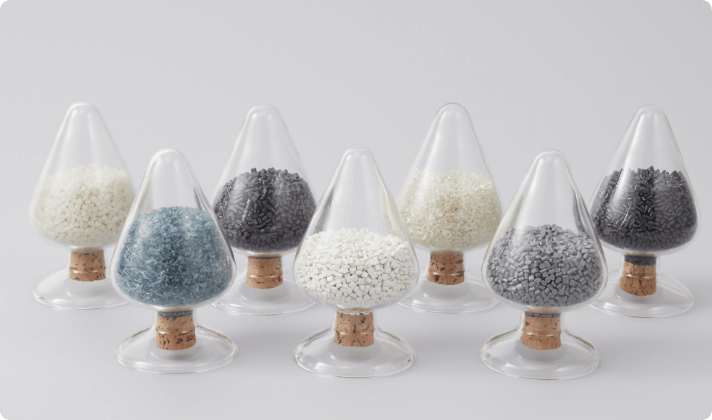
Products
Matelier utilizes waste materials that have a short usage period and relatively little deterioration. For example, milk bottles, water bottles, PET bottles, and other bottles that are discarded as soon as they are finished drinking are used as raw materials. In addition, CDs and DVDs used indoors or in cars, and amusement machines that are used in air-conditioned rooms and whose models are changed every 3 to 5 years are also utilized.
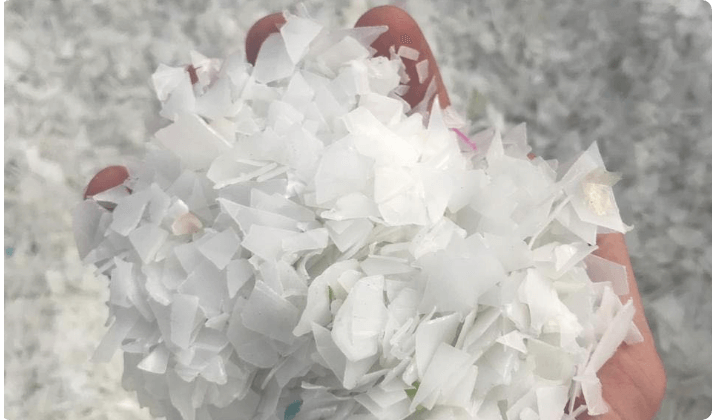
Technology
The recycled plastic developed by Konica Minolta is used in the housing of MFPs, which require highly functional materials, through high-purity and upgrade recycling technologies. These technologies have the potential to expand the use of waste plastics and contribute to the realization of a sustainable, recycling-oriented society by reducing environmental impact.
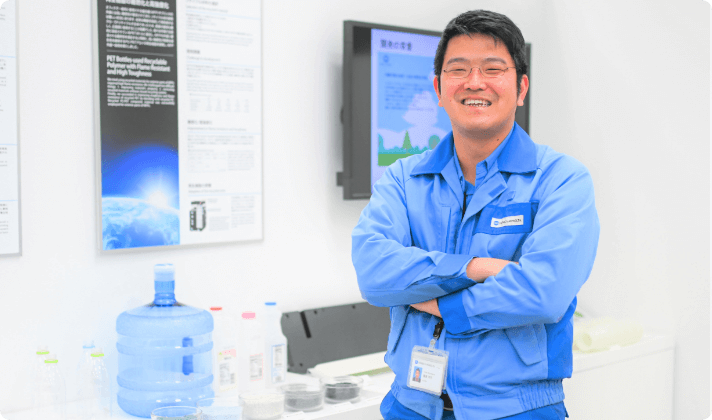
Message
Recycled plastics must offer the same or better quality, cost, and supply as petroleum-derived virgin plastics, as well as high environmental performance, making the formulation design extremely challenging. We achieved our goal by designing the entire process, including the production process, while making full use of material design/analysis/evaluation technology, one of our core technologies.
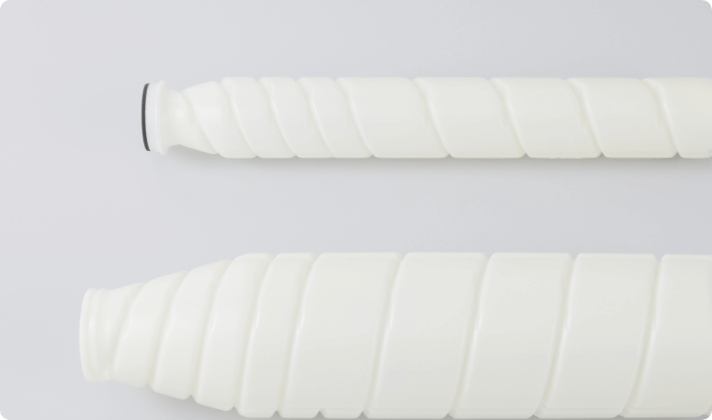
Case
Konica Minolta has been accumulating recycled plastic technology for more than 10 years. Konica Minolta has been using recycled plastic obtained through material recycling in its MFPs for more than 10 years.
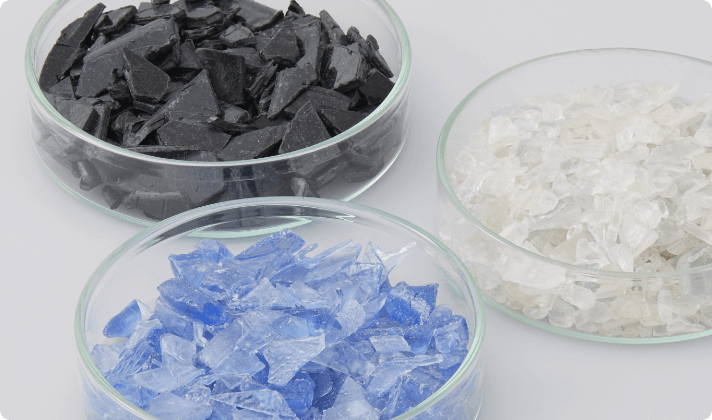
FAQ
Konica Minolta utilizes raw materials for PCR materials that have a fast replacement cycle and relatively little degradation, so there is little variation in physical properties, ensuring that the properties are almost the same as those of virgin materials.
